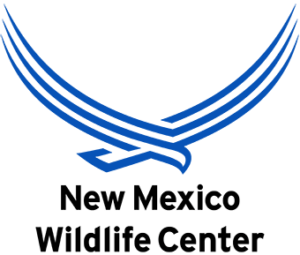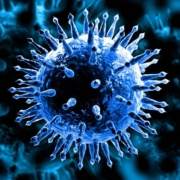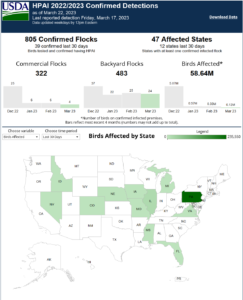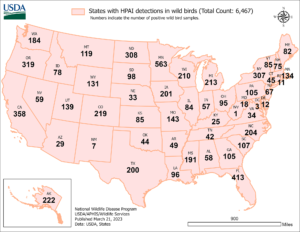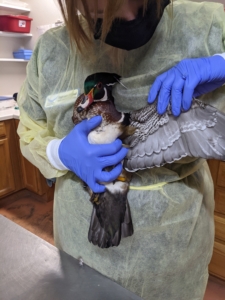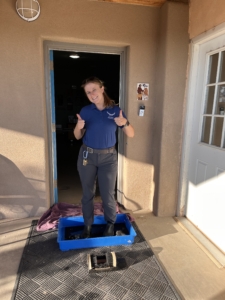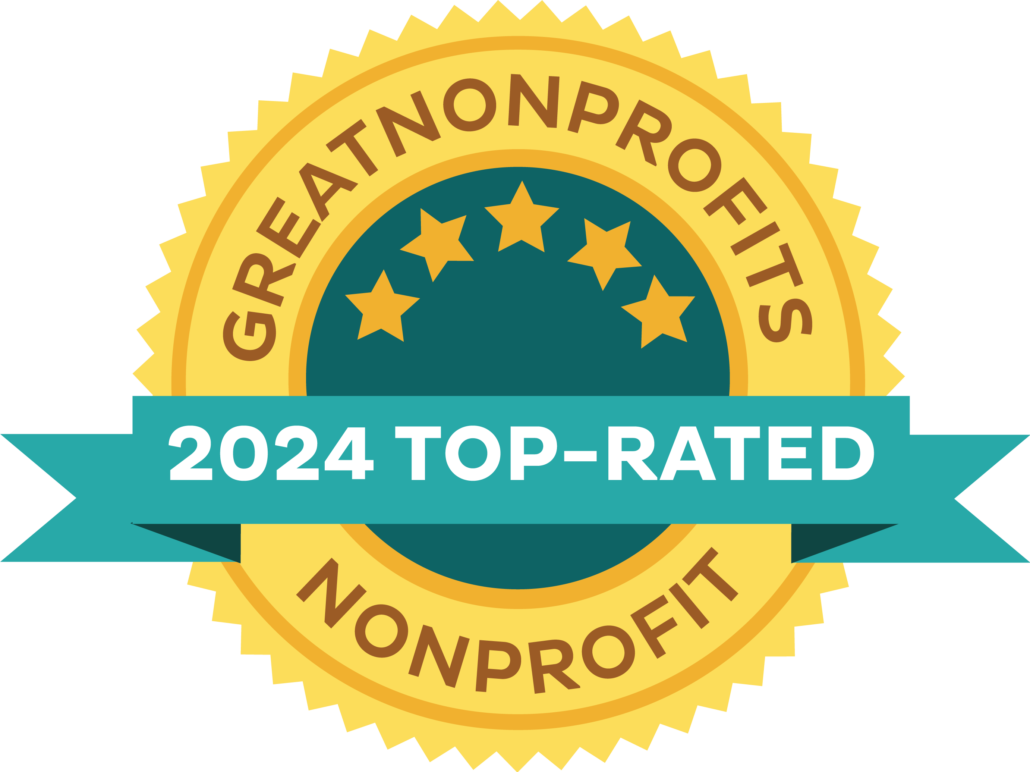March 23, 2023: Highly Pathogenic Avian Influenza
You may have heard of a bird flu going around, often referred to as HPAI. We are here to answer your questions and provide accurate, up-to-date information regarding this outbreak. If you have any further questions or concerns, call New Mexico Wildlife Center at (505) 753-9505.
On October 6, 2022 the USDA and APHIS confirmed the presence of highly pathogenic avian influenza (HPAI) in a non-commercial backyard flock (non-poultry) in Bernalillo County, New Mexico. You can read more about this case here.
There have been 7 confirmed cases in wild populations in New Mexico as of February 14, 2023.
What is HPAI?
Bird flu, as it’s known colloquially, is also called avian influenza. There are multiple types of influenza, and the kind that we worry about in birds are some of the influenza A strains. To further distinguish the strains of Influenza A, they are classified by their relevant proteins, and separated into low pathogenicity and high pathogenicity avian influenza. When you hear about avian influenza in the news, it is usually the highly pathogenic strains (HPAI). Many strains of avian influenza circulate in birds worldwide. It is closely monitored for both the health of global populations of birds as well as the risk of HPAI getting into poultry birds, which is a concern for food security and the global economy.
HPAI is transmitted bird-to-bird via ingestion or direct contact with feces or respiratory secretions from infected birds. The Fecal-Oral transmission route is most common.
Why are we hearing about HPAI in the news this year?
Some years, the strains of HPAI that circulate cause significantly more trouble than other years. This migration season is unfortunately one of the bad years.
The current strain being transmitted is a highly pathogenic form known as the H5N1 strain. There have been many deaths in wild birds and it has also caused serious concerns for farmed birds, leading to the deaths of chickens, turkeys, and other poultry.
Birds infected with this current strain of HPAI exhibit a decreased appetite, neurologic symptoms (depression, incoordination, head tilting or not being held up, not able to stand and walk), seizure activity, and eventual death.
Generally, the issues with avian influenza subside as the migration season ends. New strains will come with the next migration, and hopefully they will be less severe.
Does HPAI affect humans?
Transmission of HPAI from birds to humans is incredibly rare, but not impossible. If you do not have close contact with poultry or wild birds, the risk is extremely low.
If you do have close contact with wild birds or large poultry operations, read this article about how you can help protect yourself.
If you find a wild bird that appears to be sick, it is important that you do not come in physical contact with the bird. Before attempting to rescue the bird, contact a local wildlife rehabilitator or the state game and fish office for further guidance. If it is appropriate to take it to a local licensed wildlife rehabilitator, you must take extra safety precautions, including wearing gloves or using a towel to scoop the bird into a container. Be sure to disinfect the box before reusing. Wash hands and clothing after getting the bird safely in the care of a rehabilitator.
What governing bodies are responsible for tracking, reporting, and controlling HPAI?
HPAI is a reportable disease, which means if a veterinarian suspects that a patient is infected, they must alert the US Department of Agriculture state veterinarian, who then alerts the World Organization for Animal Health if the patient is positive for HPAI.
This global tracking system has been set up primarily in the interest of farmed bird populations.
Where is HPAI?
HPAI has been found in 49 states as of March 21, 2023. The first case in New Mexico was in a backyard flock of birds on October 6, 2022. There have been 7 confirmed positive cases in wild birds in New Mexico.
You can visit this map from USDA to get the most up-to-date information about where HPAI has been found.
What is NMWC doing to prepare for possible HPAI?
As of February 1, we are in a moderate-risk area. We do not have a significant amount of commercial poultry operations in our state, and the number of migratory birds, particularly waterfowl, with a flight path over NMWC is quite low. Based on the cases that have been detected in the state, we are currently on Level 2 of our HPAI biosecurity plan. This includes:
- Vigilantly monitoring for updates from USDA and USGS along with NMDGF for any additional information or guidance
- We are incorporating additional PPE gear for our wildlife hospital staff when handling patients that are common carriers of HPAI (mainly waterfowl) or are showing symptoms that are consistent with HPAI.
- Any patients that exhibit symptoms are immediately reported, tested and samples are sent to NM Veterinary Diagnostic Services Lab to determine if HPAI is present.
- Any patient with symptoms would be isolated from other avian patients.
In the event that HPAI comes closer to our facility, we will likely begin implementing increased biosecurity practices including:
- Diluted bleach foot baths at each door to disinfect contaminants on shoes. Staff, volunteers, visitors, and all people onsite are required to use these foot baths to ensure the safety of our Ambassador Animals and hospital patients.
- Possibly eliminating taking the avian ambassadors on programs off-site
- Limiting visitors on-site
- Adding extra biosecurity on site for our staff, interns, and volunteers
- Considering adding temporary roofing options for our ambassadors who may need extra protection
Keep an eye on this page and our social media accounts to stay informed of HPAI in New Mexico.
What can you do to help?
Just like everyone has done their part to wear a mask during the COVID-19 pandemic, it should become a courtesy to clean your shoes and gear after traveling to different locations. Our staff and volunteers know that if they have taken a weekend birding trip to the Bosque for example, they should clean their shoes before coming back to the center (How to Clean Your Hiking Boots). This should become common not just for HPAI concerns, but to decrease the spread of other pathogens as well as invasive plants.
Bird feeders- We do not currently recommend taking down bird feeders in and around Santa Fe and Rio Arriba county. However, this may change depending on if HPAI becomes prevalent in our state. Additionally, if you do have backyard chickens, you may want to find ways to decrease their fraternization with wild birds. Check out the USDA Defend the Flock website: (https://www.aphis.usda.gov/aphis/ourfocus/animalhealth/animal-disease-information/avian/defend-the-flock-program). It is extremely rare for songbirds to be diagnosed with HPAI, but corvids (ravens, crows, jays) are sometimes affected, so if the risk increases, we may put out new information that indicates what to do about common bird species in the area.
There are guidelines that the USGS has implemented and that NMWC is following regarding reporting incidences of sick or dead birds. In particular, if groups of wild birds are found deceased, particularly waterfowl or raptors, then there should be an investigation. If you see something concerning, please call Game and Fish or contact NMWC for further guidance.
Other Resources
From the National Wildlife Health Center (NWHC) through USGS
- Avian Influenza:https://www.usgs.gov/centers/nwhc/science/avian-influenza
- Avian Influenza Surveillance: https://www.usgs.gov/centers/nwhc/science/avian-influenza-surveillance
- Distribution of Highly Pathogenic Avian Influenza in North America, 2021/2022: https://www.usgs.gov/centers/nwhc/science/distribution-highly-pathogenic-avian-influenza-north-america-20212022
From the Centers for Disease Control and Prevention (CDC)
- Information and guidance regarding avian influenza: https://www.cdc.gov/flu/avianflu/prevention.htm
- Additional guidance if you have been in close contact with infected birds: https://www.cdc.gov/flu/pdf/avianflu/Bird-Flu-Exposure-Handout.pdf
From U.S. Department of Agriculture (USDA)
- Avian Influenza: https://www.aphis.usda.gov/aphis/ourfocus/animalhealth/animal-disease-information/avian/avian-influenza/ai
- 2022 Highly Pathogenic Avian Influenza: https://www.aphis.usda.gov/aphis/ourfocus/animalhealth/animal-disease-information/avian/avian-influenza/2022-hpai
- Frequently Asked Questions about Avian Influenza: https://www.aphis.usda.gov/animal_health/downloads/animal_diseases/ai/faqs.pdf
- Map of positive cases of free-ranging positive wild birds (excludes rehabilitation center cases): https://www.aphis.usda.gov/aphis/ourfocus/animalhealth/animal-disease-information/avian/avian-influenza/hpai-2022/2022-hpai-wild-birds
